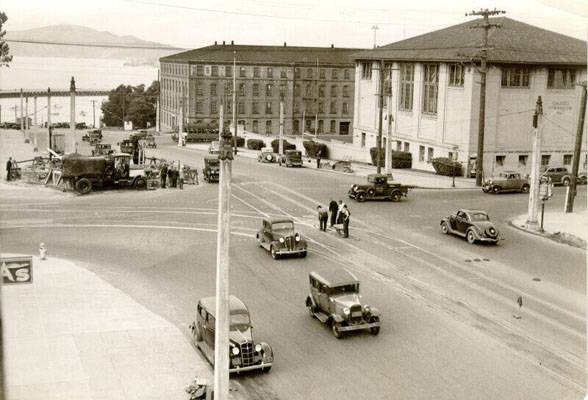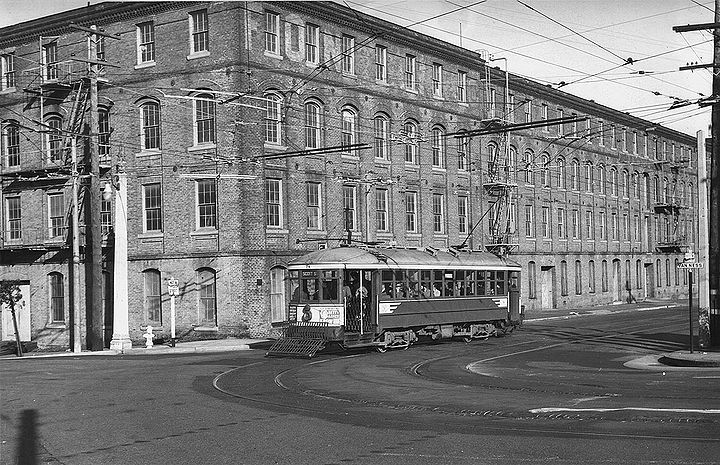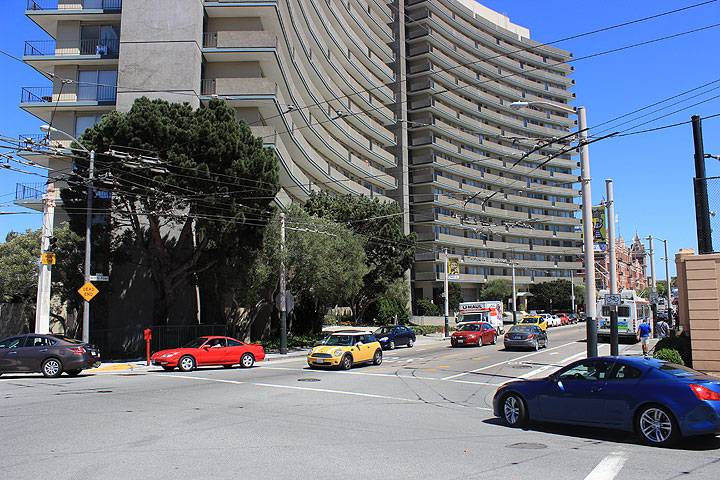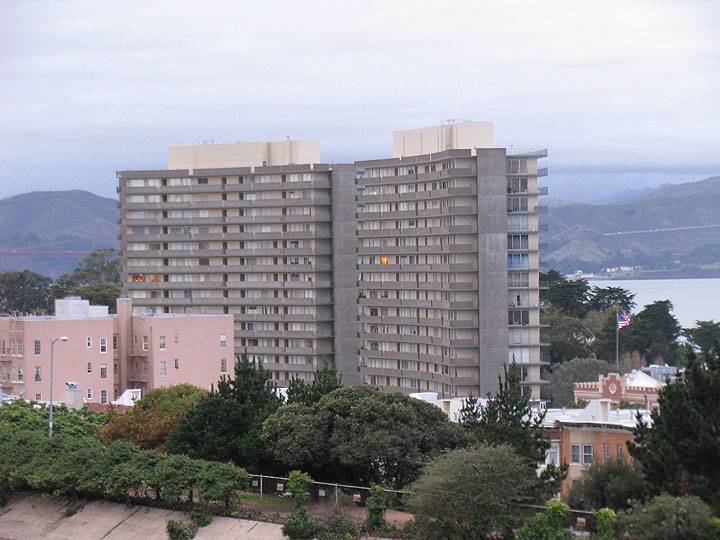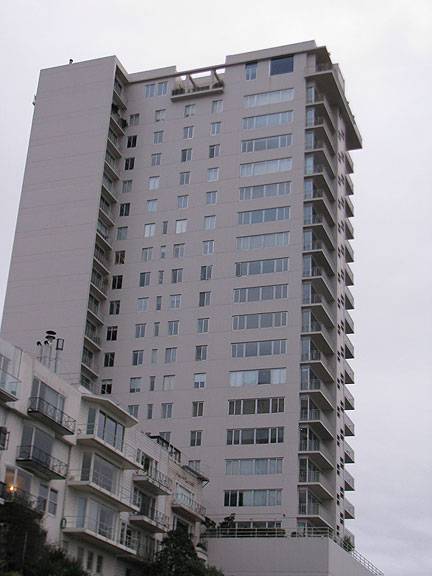Height Limit Revolt Saves Waterfront Vistas: Difference between revisions
(Created page with ''''<font face = Papyrus> <font color = maroon> <font size = 4>Historical Essay</font></font> </font>''' ''by Chris Carlsson'' During the early 1960s San Franciscans rose up to ...') |
(added new photo) |
||
| (3 intermediate revisions by the same user not shown) | |||
| Line 3: | Line 3: | ||
''by Chris Carlsson'' | ''by Chris Carlsson'' | ||
During the early 1960s San Franciscans rose up to oppose the rampant construction of highrise apartment buildings, offices, hotels, and other commercial projects that would have created a wall along the northern waterfront had they been built. It started when developers proposed building the curving 17-story towers on the site of the old Fontana spaghetti factory just east of Fort Mason. Residents living on Russian Hill, mostly upper-class San Franciscans, organized opposition through their Russian Hill Improvement Association (RHIA). What now can be seen as a curious irony a half century later, the lawyer who represented the RHIA was Casper Weinberger, who went on to be President Ronald Reagan’s Secretary of Defense during his infamous [[Let’s Fake a Deal! A History of Arms Control|military build-up and Star Wars fantasies]] of the 1980s. | During the early 1960s San Franciscans rose up to oppose the rampant construction of highrise apartment buildings, offices, hotels, and other commercial projects that would have created a wall along the northern waterfront had they been built. It started when developers proposed building the curving 17-story towers on the site of the old Fontana spaghetti factory just east of Fort Mason. Residents living on Russian Hill, mostly upper-class San Franciscans, organized opposition through their Russian Hill Improvement Association (RHIA). What now can be seen as a curious irony a half century later, the lawyer who represented the RHIA was Casper Weinberger, who went on to be President Ronald Reagan’s Secretary of Defense during his infamous [[Let’s Fake a Deal! A History of Arms Control|military build-up and Star Wars fantasies]] of the 1980s. | ||
[[Image:Feb 21 1936 van ness and bay streets AAB-5701.jpg]] | |||
'''Van Ness Avenue and Bay Street, February 21, 1936, old Fontana spaghetti factory is brick building one block north on right.''' | |||
''Photo: San Francisco History Center, SF Public Library'' | |||
[[Image:Van-Ness-and-North-Point-c-1940s.jpg|720px]] | |||
'''Fontana Spaghetti Factory at North Point and Van Ness, 1940s.''' | |||
''Photo: Charles Ruiz collection'' | |||
[[Image:Fontana-towers-at-corner 3745.jpg]] | |||
'''Fontana Towers built in 1962 on site of spaghetti factory/warehouse at North Point and Van Ness, seen here in 2014.''' | |||
''Photo: Chris Carlsson'' | |||
[[Image:Fontana-Towers-cu 1302.jpg]] | [[Image:Fontana-Towers-cu 1302.jpg]] | ||
| Line 13: | Line 31: | ||
Citizen efforts were helped by a 1960 declaration from then planning director James R. McCarthy where he was one of the first to warn against “Manhattanization.” He said, “San Francisco zoning laws will have to be changed to prevent construction of a ‘Chinese Wall’ of skyscrapers along its waterfront… We want to avoid what has happened in lower Manhattan in New York, where views of the bay are blocked by high rising buildings.” (S.F. Chronicle, Dec. 7, 1960). But the well-heeled denizens of Russian Hill began their campaign too late to stop the Fontana Towers, which were built. These modernist towers are still reviled by most San Franciscans, but their construction helped fuel a broader movement to halt such building along the waterfront from Fishermans’ Wharf to the Bay Bridge. | Citizen efforts were helped by a 1960 declaration from then planning director James R. McCarthy where he was one of the first to warn against “Manhattanization.” He said, “San Francisco zoning laws will have to be changed to prevent construction of a ‘Chinese Wall’ of skyscrapers along its waterfront… We want to avoid what has happened in lower Manhattan in New York, where views of the bay are blocked by high rising buildings.” (S.F. Chronicle, Dec. 7, 1960). But the well-heeled denizens of Russian Hill began their campaign too late to stop the Fontana Towers, which were built. These modernist towers are still reviled by most San Franciscans, but their construction helped fuel a broader movement to halt such building along the waterfront from Fishermans’ Wharf to the Bay Bridge. | ||
After the Fontana project was approved, the RHIA and their lawyer Weinberger embraced the idea of a 40-foot height limit (about three or four stories) to protect the waterfront from future such projects. The Planning Commission, under pressure from RHIA and its allies, voted in June 1961 for a two-year temporary 40-foot height limit on a 100-block area of the northern waterfront. Casper Weinberger, who had been a 3-term Republican state assemblymember in the 1950s, argued for a broader political goal to establish a “flexible height limit that will allow progress but not destroy views or the sense of being near the bay… and a city-wide campaign to preserve San Francisco’s waterfront beauty.” (By mid-1962 Weinberger had become state chairman of the California Republican Party, later serving as Governor Reagan’s Finance Director, where he supported the consolidation and permanence of the Bay Conservation and Development Commission which had been created in response to the [[SAVING SAN FRANCISCO BAY|Save the Bay movement]].) A broad coalition consisting of twenty-two improvement groups and neighborhood associations, including the [[The History of Telegraph Hill Dwellers | After the Fontana project was approved, the RHIA and their lawyer Weinberger embraced the idea of a 40-foot height limit (about three or four stories) to protect the waterfront from future such projects. The Planning Commission, under pressure from RHIA and its allies, voted in June 1961 for a two-year temporary 40-foot height limit on a 100-block area of the northern waterfront. Casper Weinberger, who had been a 3-term Republican state assemblymember in the 1950s, argued for a broader political goal to establish a “flexible height limit that will allow progress but not destroy views or the sense of being near the bay… and a city-wide campaign to preserve San Francisco’s waterfront beauty.” (By mid-1962 Weinberger had become state chairman of the California Republican Party, later serving as Governor Reagan’s Finance Director, where he supported the consolidation and permanence of the Bay Conservation and Development Commission which had been created in response to the [[SAVING SAN FRANCISCO BAY|Save the Bay movement]].) A broad coalition consisting of twenty-two improvement groups and neighborhood associations, including the [[The History of Telegraph Hill Dwellers |Telegraph Hill Dwellers]], managed to get 8,000 signatures on a petition supporting the 40-foot height limit. | ||
The San Francisco Real Estate Board, the Building Owners and Managers Association, the Associated General Contractors, and the San Francisco Building Trades Council all moved to fight the 40-foot height limit, arguing that the proponents were only concerned with beauty, overcrowding, sunshine and shadows, and not economics. But Planning Commissioners were not responsive to the narrow interests of real estate developers at this time. After various legislative maneuvers to end the restriction at the Board of Supervisors even the pro-development Mayor Christopher publicly supported a more deliberate process by planning experts. The Planning Department continued to advocate for the height restrictions, and the Board voted 9-0 in favor of the interim controls, endorsing public arguments that such things as enjoyment of nature and views belong to everyone and should not be sacrificed to private real estate interests. | The San Francisco Real Estate Board, the Building Owners and Managers Association, the Associated General Contractors, and the San Francisco Building Trades Council all moved to fight the 40-foot height limit, arguing that the proponents were only concerned with beauty, overcrowding, sunshine and shadows, and not economics. But Planning Commissioners were not responsive to the narrow interests of real estate developers at this time. After various legislative maneuvers to end the restriction at the Board of Supervisors even the pro-development Mayor Christopher publicly supported a more deliberate process by planning experts. The Planning Department continued to advocate for the height restrictions, and the Board voted 9-0 in favor of the interim controls, endorsing public arguments that such things as enjoyment of nature and views belong to everyone and should not be sacrificed to private real estate interests. | ||
| Line 25: | Line 43: | ||
''Photo: Chris Carlsson'' | ''Photo: Chris Carlsson'' | ||
During those early ‘60s years Weinberger was in the mainstream of the Republican Party, when it still had room for conservationists, once an important part of the Party’s history (going back to Teddy Roosevelt and the early conservationist movement at the turn of the 20th century). Weinberger rode the Reagan train into state and then national power, moving steadily to the right along with the political leader that he followed. The far right’s capture of the Republican Party in the 2000s required the legacy of Reaganism to succeed, but has had to obliterate the actual history of the Republicans that preceded the 1970s. Oddly and ironically for San Francisco, Weinberger’s words were very influential and bolstered a series of social and ecological movements (such as the Freeway Revolt, the Save the Bay movement, efforts to preserve open space, etc.) that later became ideological targets of right-wing politicians across the U.S. | During those early ‘60s years Weinberger was in the mainstream of the Republican Party, when it still had room for conservationists, once an important part of the Party’s history (going back to Teddy Roosevelt and the early conservationist movement at the turn of the 20th century). Weinberger rode the Reagan train into state and then national power, moving steadily to the right along with the political leader that he followed. The far right’s capture of the Republican Party in the 2000s required the legacy of Reaganism to succeed, but has had to obliterate the actual history of the Republicans that preceded the 1970s. Oddly and ironically for San Francisco, Weinberger’s words were very influential and bolstered a series of social and ecological movements (such as the [[The Freeway Revolt|Freeway Revolt]], the [[SAVING SAN FRANCISCO BAY|Save the Bay movement]], efforts to [[Ecology Emerges 1970s|preserve open space]], etc.) that later became ideological targets of right-wing politicians across the U.S. | ||
<hr> | <hr> | ||
| Line 31: | Line 49: | ||
''This article based on Jasper Rubin’s excellent work “A Negotiated Landscape: The Transformation of San Francisco’s Waterfront Since 1950” (The Center for American Places at Columbia College, Chicago: 2011)'' | ''This article based on Jasper Rubin’s excellent work “A Negotiated Landscape: The Transformation of San Francisco’s Waterfront Since 1950” (The Center for American Places at Columbia College, Chicago: 2011)'' | ||
[[category:1960s]] [[category:Russian Hill]] [[category:architecture]] [[category:Power and Money]] [[category:Real | [[category:1960s]] [[category:Russian Hill]] [[category:architecture]] [[category:Power and Money]] [[category:Real estate]] [[category:Ecology]] | ||
Latest revision as of 16:15, 31 August 2014
Historical Essay
by Chris Carlsson
During the early 1960s San Franciscans rose up to oppose the rampant construction of highrise apartment buildings, offices, hotels, and other commercial projects that would have created a wall along the northern waterfront had they been built. It started when developers proposed building the curving 17-story towers on the site of the old Fontana spaghetti factory just east of Fort Mason. Residents living on Russian Hill, mostly upper-class San Franciscans, organized opposition through their Russian Hill Improvement Association (RHIA). What now can be seen as a curious irony a half century later, the lawyer who represented the RHIA was Casper Weinberger, who went on to be President Ronald Reagan’s Secretary of Defense during his infamous military build-up and Star Wars fantasies of the 1980s.
Van Ness Avenue and Bay Street, February 21, 1936, old Fontana spaghetti factory is brick building one block north on right.
Photo: San Francisco History Center, SF Public Library
Fontana Spaghetti Factory at North Point and Van Ness, 1940s.
Photo: Charles Ruiz collection
Fontana Towers built in 1962 on site of spaghetti factory/warehouse at North Point and Van Ness, seen here in 2014.
Photo: Chris Carlsson
Fontana Towers, 2012.
Photo: Chris Carlsson
Citizen efforts were helped by a 1960 declaration from then planning director James R. McCarthy where he was one of the first to warn against “Manhattanization.” He said, “San Francisco zoning laws will have to be changed to prevent construction of a ‘Chinese Wall’ of skyscrapers along its waterfront… We want to avoid what has happened in lower Manhattan in New York, where views of the bay are blocked by high rising buildings.” (S.F. Chronicle, Dec. 7, 1960). But the well-heeled denizens of Russian Hill began their campaign too late to stop the Fontana Towers, which were built. These modernist towers are still reviled by most San Franciscans, but their construction helped fuel a broader movement to halt such building along the waterfront from Fishermans’ Wharf to the Bay Bridge.
After the Fontana project was approved, the RHIA and their lawyer Weinberger embraced the idea of a 40-foot height limit (about three or four stories) to protect the waterfront from future such projects. The Planning Commission, under pressure from RHIA and its allies, voted in June 1961 for a two-year temporary 40-foot height limit on a 100-block area of the northern waterfront. Casper Weinberger, who had been a 3-term Republican state assemblymember in the 1950s, argued for a broader political goal to establish a “flexible height limit that will allow progress but not destroy views or the sense of being near the bay… and a city-wide campaign to preserve San Francisco’s waterfront beauty.” (By mid-1962 Weinberger had become state chairman of the California Republican Party, later serving as Governor Reagan’s Finance Director, where he supported the consolidation and permanence of the Bay Conservation and Development Commission which had been created in response to the Save the Bay movement.) A broad coalition consisting of twenty-two improvement groups and neighborhood associations, including the Telegraph Hill Dwellers, managed to get 8,000 signatures on a petition supporting the 40-foot height limit.
The San Francisco Real Estate Board, the Building Owners and Managers Association, the Associated General Contractors, and the San Francisco Building Trades Council all moved to fight the 40-foot height limit, arguing that the proponents were only concerned with beauty, overcrowding, sunshine and shadows, and not economics. But Planning Commissioners were not responsive to the narrow interests of real estate developers at this time. After various legislative maneuvers to end the restriction at the Board of Supervisors even the pro-development Mayor Christopher publicly supported a more deliberate process by planning experts. The Planning Department continued to advocate for the height restrictions, and the Board voted 9-0 in favor of the interim controls, endorsing public arguments that such things as enjoyment of nature and views belong to everyone and should not be sacrificed to private real estate interests.
Before the February 1964 vote of the Board of Supervisors overwhelmingly approved permanent 40-foot height limits (voting 9-1 in favor), Casper Weinberger had argued that the law “will preserve for future generations one of the priceless assets of San Francisco, the whole relationship of the city to the Bay… and particularly, the views enjoyed by the public from publicly owned lands, such as Coit Tower and other city-owned recreational spaces.” In further testimony he continued “The Master Plan has for years provided that the height of buildings should generally follow the contour of the land, and that low rise buildings should be built on the low lands, such as the northern waterfront, and high rise at the tops of hills so that the loss of views, etc., will be minimized.”
Towers such as this one dominate the upper slopes of Russian Hill, where highrises have been given free reign.
Photo: Chris Carlsson
During those early ‘60s years Weinberger was in the mainstream of the Republican Party, when it still had room for conservationists, once an important part of the Party’s history (going back to Teddy Roosevelt and the early conservationist movement at the turn of the 20th century). Weinberger rode the Reagan train into state and then national power, moving steadily to the right along with the political leader that he followed. The far right’s capture of the Republican Party in the 2000s required the legacy of Reaganism to succeed, but has had to obliterate the actual history of the Republicans that preceded the 1970s. Oddly and ironically for San Francisco, Weinberger’s words were very influential and bolstered a series of social and ecological movements (such as the Freeway Revolt, the Save the Bay movement, efforts to preserve open space, etc.) that later became ideological targets of right-wing politicians across the U.S.
This article based on Jasper Rubin’s excellent work “A Negotiated Landscape: The Transformation of San Francisco’s Waterfront Since 1950” (The Center for American Places at Columbia College, Chicago: 2011)

